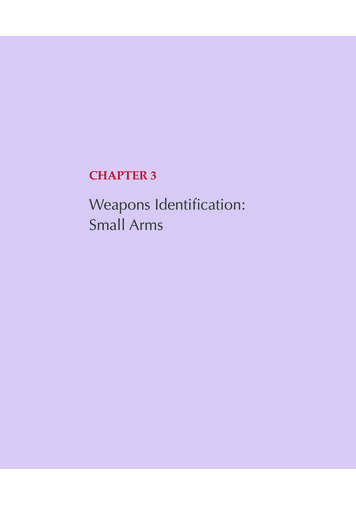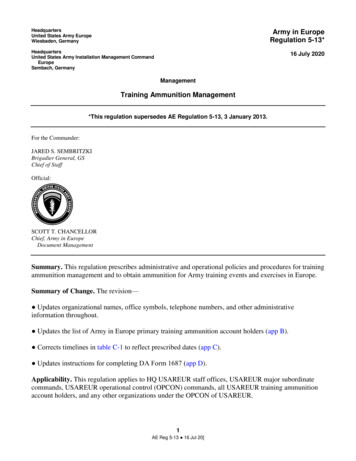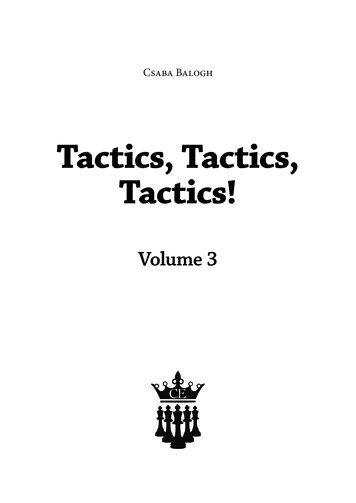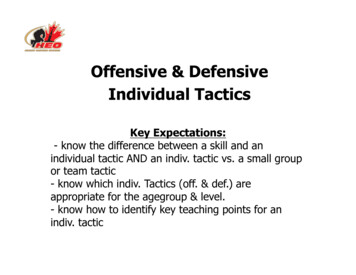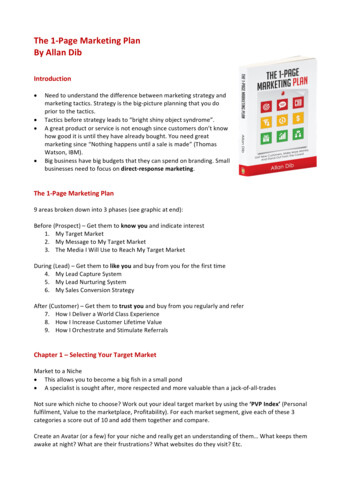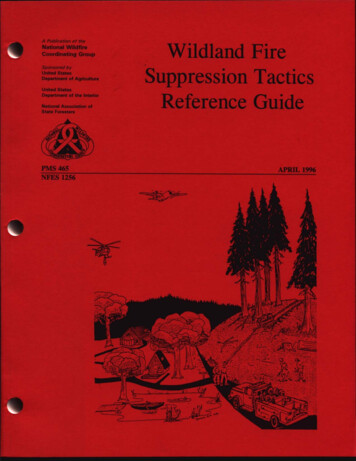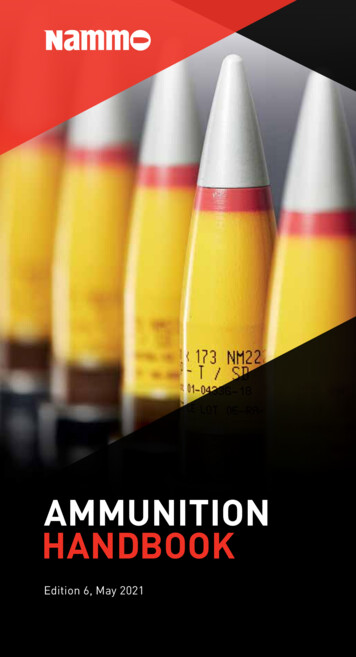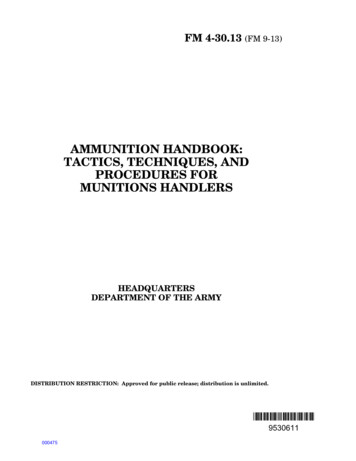
Transcription
FM 4-30.13 (FM 9-13)AMMUNITION HANDBOOK:TACTICS, TECHNIQUES, ANDPROCEDURES FORMUNITIONS HANDLERSHEADQUARTERSDEPARTMENT OF THE ARMYDISTRIBUTION RESTRICTION: Approved for public release; distribution is unlimited.*9530611*9530611000475
FM 4-30.13PREFACEThis field manual provides ready reference and guidance for units and soldiersthat handle munitions items. It is not a comprehensive manual, but it doesprovide useful data on important points of munitions service support. Also, it is atraining tool for munitions units and soldiers.Focus is on tactics, techniques, and procedures used by soldiers handlingmunitions. The information and guidance contained herein will help them tosafely receive, ship, store, handle, maintain, and issue munitions. The manualprovides information on processing unit turn-ins, destroying unserviceablemunitions, and transporting munitions in new, maturing, or mature theaters ofoperations in support of the force projection Army. The information in this manualconforms to the procedures of MOADS, MOADS-PLS, and modularty, and willtake munitions units well into the twenty-first century.The proponent for this publication is United States Army Combined Arms SupportCommand & Ft Lee (USACASCOM&FL). Send comments and recommendationson DA Form 2028 (or in 2028 format) directly to Commander, USACASCOM&FL,Directorate of Combat Developments, ATTN: ATCL O, 3901 A Avenue, Suite 250,Fort Lee, VA 23801-1809.v000476
*FM 4-30.13Field ManualNo. 4-30.13HeadquartersDepartment of the ArmyWashington, DC, 1 March 2001Ammunition Handbook:Tactics, Techniques, and Procedures forMunitions HandlersContentsPagePREFACE .vChapter 1TACTICAL UNIT OPERATIONS. 1-0Strategic, Operational, and Tactical Functions . 1-0Theater Structure . 1-0Munitions Support . 1-1Organization for Ammunition Support. 1-2Tactical Movement Operations . 1-10Summary. 1-15Chapter 2PLANNING COMBAT AND STABILITY AND SUPPORT OPERATIONS . 2-0Defining Combat and SASO Missions . 2-0Class V Support Operations . 2-1Transition to Combat/SASO. 2-4Post-Combat/SASO Transition . 2-5Summary. 2-6DISTRIBUTION RESTRICTION: Approved for public release; distribution is unlimited.*This publication supersedes FM 9-13, 4 November 1986, and FM 9-38, 2 July 1993.i000477
FM 4-30.13PageChapter 3MUNITIONS SUPPLY PROCEDURES. 3-1Receipt . 3-1Turn-Ins. 3-5Issues. 3-7Shipments . 3-12Summary. 3-17Chapter 4DIVISION AMMUNITION OFFICE AND AMMUNITION TRANSFER POINT . 4-0Division Ammunition Office. 4-0Ammunition Transfer Point . 4-2Munitions-Related Functions . 4-3Echelons Above Division . 4-5DAO and ATP Operations. 4-6Summary. 4-16Chapter 5MUNITIONS SUPPORT IN AN NBC ENVIRONMENT. 5-0Overview . 5-0Nuclear Weapons . 5-0Biological Weapons . 5-1Chemical Weapons. 5-2NBC Defensive Fundamentals . 5-2NBC Contamination . 5-3Decontamination Concepts. 5-4Summary. 5-8Chapter 6STANDARD ARMY AMMUNITION SYSTEM-MODERNIZATION . 6-1Overview . 6-1Operating Environment . 6-1SAAS Area Functions . 6-2System Performance . 6-5Required Hardware. 6-6Required Software . 6-7Contingencies . 6-7Problem Reports . 6-7Summary. 6-8ii000478
FM 4-30.13Chapter 7MUNITIONS SAFETY. 7-1Safety Levels . 7-1Risk Assessment and Management . 7-2Accident and Incident Control Plan. 7-13Reporting Munitions Malfunctions. 7-13Summary. 7-13Chapter 8FIRE PROTECTION, PREVENTION, AND SAFETY AWARENESS . 8-1Fire Protection Program. 8-1Fire Prevention Components . 8-1Fire Hazards and Symbols. 8-5Chemical Hazards and Symbols. 8-8Responding to Munitions Fires . 8-11Summary. 8-13Chapter 9MUNITIONS STORAGE PROCEDURES . 9-0Overview . 9-0Ammunition Storage Activities . 9-0Storage Safety Principles. 9-3Site Selection . 9-7Storage Area Planning. 9-10Rewarehousing Munitions. 9-19Night Operations . 9-19Summary. 9-20Chapter 10MUNITIONS MAINTENANCE AND SURVEILLANCE OPERATIONS . 10-1Maintenance Planning . 10-1Maintenance Operations. 10-1Surveillance Operations. 10-3Safety . 10-7Summary. 10-7Chapter 11EMERGENCY DESTRUCT OPERATIONS . 11-0Operations Objectives. 11-0Methods of Destruction . 11-3Summary. 11-6iii000479
FM 4-30.13Chapter 12CAPTURED ENEMY AMMUNITION. 12-1Historical Perspective . 12-1TECHINT Mission . 12-2Unit Responsibilities. 12-6Capture and Reporting Procedures . 12-8TECHINT Reporting Procedures . 12-8Procedures for Moving CEA . 12-9CMEC Processing of CEA . 12-13Management and Disposal of CEA. 12-13Summary. 12-14Appendix AAMMUNITION BASIC LOAD . A-1Appendix BGUIDANCE FOR COMMANDERS . B-0Appendix CFORECASTING AND MANAGING TRAINING AMMUNITION.C-1Appendix DBRASS CONVERSION .D-0Appendix EAMMUNITION CONDITION CODES . E-0Appendix FAMMUNITION IDENTIFICATION. F-1Appendix GMOVEMENT CONTROL AND TYPES OF TRANSPORT . G-0Appendix HHAZARDOUS MATERIALS INFORMATION .H-1Appendix ISTORAGE COMPATIBILITY GROUPS . I-0Appendix JFORWARD ARMING AND REFUELING POINTS . J-0Appendix KSLING LOAD OPERATIONS . K-1GLOSSARY . Glossary-0BIBLIOGRAPHY . Bibliography-1INDEX . Index-0iv000480
Chapter 1Tactical Unit OperationsThis chapter discusses munitions support and tactical unit operationswithin the theater structure. Munitions directly impact the success oftactical operations. It is the function of ammunition companies andmodular ammunition platoons in the theater of operations to best supportthe operational plans of tactical commanders. Ammunition unit tacticallevel operations include activities necessary to support and win in combatas well as activities that precede and follow them.STRATEGIC, OPERATIONAL, AND TACTICAL FUNCTIONS1-1. Power projection is the ability of a military force to deploy air, land, andsea forces to any region of the world and to sustain them for any type ofmission. Power projection is a central strategic concept of US militarystrategy. Force projection, the Army’s contribution to this joint effort, is thedemonstrated ability to rapidly alert, mobilize, and field a force that isdeployable, lethal, versatile, expandable, and sustainable.1-2. Army CSS operates in a seamless continuum throughout the strategic,operational, and tactical environments. Strategic CSS maintains the nationalsustainment base and supports force projection. Operational CSSaccomplishes operational plans by linking tactical requirements to strategiccapabilities. Operational level support personnel are aware of the combatcommander’s theater strategic perspective and requirements at the tacticallevel. Tactical CSS focuses on coordinated, tailored warfighter support bymanning, arming, fueling, fixing, moving, and sustaining the soldier and hisequipment. The following section briefly describes theater structure toprovide context for the discussion of tactical unit operations.THEATER STRUCTURE1-3. A theater is a geographical area located OCONUS for which acommander is assigned military responsibility. International militarycooperation and the degree of dedicated US forces influence how the Armyconducts operations in each theater.THEATER OF WAR1-4. When combat operations are authorized, a strategic theater of war isdelineated. It may include part or all of the original peacetime theater. Partof the theater may be in a state of war while other areas remain at peace.THEATER OF OPERATIONS1-5. To contend with more than one threat, the theater of war may besubdivided into subordinate theaters or areas of operation. Theaters ofoperation are those portions of an area of war required for military operationsand for administering those operations.1-0000481
FM 4-30.13COMMUNICATIONS ZONE1-6. The COMMZ extends from the rear of the combat zone in the theater ofoperations to the CONUS base. Its size depends on the size of the theater ofoperations and the size of the force required for operation and sustainment.Within the COMMZ is the theater logistics base. It contains logistic facilitiesneeded to support the theater; these include APOD/SPOD, storage areas,logistics headquarters, and units essential to munitions support.CORPS/DIVISION OPERATIONS1-7. A corps and/or division(s) operates in a defined theater as a forwardpresence to deter or combat threats. A corps normally fights as an element ofa joint/combined or multinational force in cooperation with the Air Force,Navy, Marine Corps, and allied forces. It is tailored for the theater andmission operations and can fight only as long as the COSCOM providesmunitions and logistical support.MUNITIONS SUPPORT1-8. Munitions units are required to provide support for SASO and offensive,defensive, and contingency operations. Also, they support other missions asassigned in both theater and corps areas of operation.OFFENSIVE OPERATIONS1-9. Logistic assets, including ammunition companies/platoons, are essentialto maintaining the momentum of offensive operations. The corps goal is tosupport maneuver and CS units engaged in the main battle. Units thathandle, store, and supply munitions must be mobile and prepared to move asoften as the combat force requires. Types of offensive operations includemovement to attack, hasty attack, deliberate attack, exploitation, andpursuit.DEFENSIVE OPERATIONS1-10. At any time, combat units defend, delay, move out of contact, or executewithdrawals. The object of defensive operations is failure of an enemy attack.Defensive operations also allow US forces to gain time, to concentrateelsewhere, to hold key objectives, or to wear down the enemy before going onthe offensive. Types of defensive operations include support of a coveringforce, main battle force, or a mixture of heavy, light, and reserve forces.CONTINGENCY OPERATIONS1-11. US forces may be required to serve as a contingency force in anundeveloped area where a US military infrastructure does not exist. Such anoperation typically might be one in which an undeveloped, friendly HNrequests military assistance. A contingency force would conduct combatoperations short of war but necessary to defeat threat forces or expel themfrom occupied territory. The size of this force would be tailored to the threatand the environment. Initially, it could be smaller than a division but couldbe expanded rapidly. The munitions support structure would also be tailored1-1000482
FM 4-30.13and, depending on METT-TC, may include only elements of DS companies ormodular ammunition platoons to operate ASPs or ATPs.STABILITY AND SUPPORT OPERATIONS1-12. SASO may be necessary to maintain a negotiated truce or to achieve,restore, or maintain a diplomatic resolution or peace in a hostile area or anarea of potential conflict. Forces involved in such operations are traditionallymultinational. The munitions force structure may be tailored to support bothUS and multinational forces for short or extended periods in a bare-baseenvironment in conjunction with HNS. Most likely, the munitions force wouldconsist of DS companies, modular ammunition platoons, or ammunitiontransfer point sections.ORGANIZATION FOR AMMUNITION SUPPORT1-13. The munitions force structure is evolving. This should be remembered,regardless of the type of operation ammunition units are required to support.In the near term, and well into the twenty-first century, ammunition unitswill continue to become smaller in size. At the same time, they will becomemore flexible and capable of deploying more rapidly, operating moreefficiently at higher levels of productivity. This process will be in cooperationwith elements from other services, multinational forces, other governmentaland nongovernmental organizations, DOD civilians, and contract personnel.MODULARITY1-14. The structure of ammunition units and the munitions support concept isrevised as combat doctrine evolves. MOADS doctrine and force structure weredesigned to support a forward-deployed force. In the near future, MOADSwill transition to a more flexible distribution system based on the concept ofmodularity. A munitions structure based on modularity will more effectivelymeet the needs of a force projection Army. Under this concept, only thenumber of soldiers, DOD civilians, and the equipment needed to support theforce are deployed.1-15. The advent of modular munitions units has drastically increased theflexibility of the ASCC and joint commanders during combat and SASO.Unlike MOADS-PLS units, modular companies and platoons are 100 percentmobile (less munitions stocks). This mobility is particularly important forsplit-based and contingency operations. The ability of a modular platoon todeploy independent of its company headquarters allows the ASCC to rightsize his forces for combat and SASO. Although modular platoons andcompanies are 100 percent mobile, they are not 100 percent sustainable.These units must be attached to a higher headquarters (i.e., company orbattalion) for administrative and logistical support and C2.1-16. The following sections provide a general overview of the typicalordnance company/battalion structure. The C2 structure in a tacticalenvironment may not follow a functional “stovepipe” alignment. Modularammunition platoons may be required to operate independent of theircompanies and within a C2 structure that is multifunctional, particularly atbattalion and higher.1-2000483
FM 4-30.13COMPANY STAFF AND RESPONSIBILITIES1-17. The company typically has a rudimentary structure and relies on itsparent battalion for CSS assets. Key personnel within the structure havemajor responsibilities that impact unit operations. These personnel, alongwith their duties and responsibilities are discussed below. Ammunition TOEmust be consulted for specific type units.Company Commander1-18. The company commander is responsible for unit training, safety, anddiscipline and directs and supervises all phases of operations andemployment. The CO is advised and assisted by his officers and NCOs.Among the most important duties and responsibilities of the companycommander are the following: Leads, plans, directs, and supervises company operations; guides theunit in carrying out its mission.Establishes unit policies and procedures.Establishes and maintains operations security consistent withguidance from higher headquarters.Initiates and ensures adherence to the unit safety program.Ensures that unit readiness is maintained.1-19. The company commander must be personally involved in planning andcarrying out unit training IAW FM 25-100 and FM 25-101. Other relatedduties include the following: Performs periodic inspections to determine unit readiness.Stresses principles of accountability and maintenance.Instructs and cross-trains subordinates.Executive Officer1-20. The XO coordinates administrative and logistical support for thecompany. In the absence of the commander, the XO is in command. Duringmodular or split-based operations, the XO takes command of the portion ofthe company in the rear location. Supervision of internal security andcoordination with the battalion staff are among the XO's responsibilities.First Sergeant1-21. The first sergeant is the senior NCO in the company and assists thecompany commander in carrying out his responsibilities. The first sergeantmust fully understand the company’s mission and be able to adjustadministrative requirements to accomplish that mission. First sergeantduties include the following: Calls formations.Manages the company headquarters.Coordinates company headquarters.Serves as intermediary between the commander and unit enlistedpersonnel.1-3000484
FM 4-30.13 Assumes duties of the commander in the absence of all other officers.Plans and posts company details in cooperation with operationalpersonnel.Maintains duty rosters.Exercises supervisory responsibility over housekeeping, work details,police, maintenance, and construction projects in the company areas.Assists the commander in advising enlisted personnel on personalmatters.Advises the company commander on personnel and morale problems.Ammunition Warrant Officer1-22. The ammunition warrant officer at the company level is responsible forall technical aspects of munitions operations. His primary focus is the safereceipt, storage, and issue of munitions stocks in support of the operationdesignated by the ASCC or joint commander. He instructs unit personnel inall aspects of munitions operations. He normally serves as the accountableofficer or storage officer for all munitions stocks stored by the company. Hewill also act as the accountable officer for stocks held by a platoon duringsplit-based operations. During split-based operations he may assume moreadministrative duties while serving as second in command to the platoonleader. Also, he may be called on to provide technical and munitions doctrinaladvise to the ASCC as one of the senior munitions logisticians in the AO.Other specific duties of the ammunition warrant officer include– Directs and coordinates destruction and demilitarization ofconventional ammunition, missile explosive components, and otherexplosive items.Directs and coordinates surveillance tests, modifications, andmaintenance of conventional ammunition, missile explosivecomponents, and other explosive items in coordination withQASAS/qualified military ammunition inspectors.Supervises and manages SAAS-MOD (ASP) and its associated ADPequipment.Prepares and/or reviews ammunition storage waivers.Prepares, reviews, and/or implements firefighting procedures.Plans, reviews, and/or implements emergency destruction ofammunition, missiles, and other explosive items.Manages, examines, interprets, disseminates, and verifiesrequirements for ammunition technical publications in the unit.Plans for and schedules work requirements, observes work practices,detects and corrects unsafe or improper procedures and techniques.Ensures ammunition QA/QC procedures are followed.Automotive Maintenance Warrant Officer1-23. The automotive maintenance warrant officer is responsible formaintaining unit automotive equipment and training and supervisingmaintenance personnel. The maintenance tech coordinates with maintenancesupport units and performs the following duties:1-4000485
FM 4-30.13 Manages the unit maintenance program.Assists and advises the company commander in assigningmaintenance personnel.Advises the commander on maintenance matters and problems.Prepares the maintenance portion of the unit SOP.Ensures that replacement parts are available or are on request.Conducts maintenance inspections, supervises maintenanceinspections, and ensures that records are maintained.Motor Sergeant1-24. The motor sergeant is chief assistant to the maintenance officer andresponsible for the proper maintenance of unit vehicles. The motor sergeantis supervised by the automotive maintenance warrant officer. He assists inorganizing the maintenance program and operates it IAW soundmaintenance procedure, as follows: Assigns tasks. Implements work schedules established by the maintenance officer. Inspects work performed by unit mechanics. Enforces safety practices.Platoon Leader1-25. Much like platoon leaders in any military unit, the munitions unitplatoon leader is responsible for training and discipline. Also, the platoonleader of a munitions unit supervises personnel in munitions storage, receipt,issue, and maintenance operations.1-26. The platoon leader ensures that the platoon carries out the companycommander's instructions. He trains the platoon with a dual purpose. First,the platoon must be developed and trained as part of the company team.Second, the platoon must be trained to be self-reliant since it may bedetached from the company and operated as a separate unit. In the lattercase, the platoon leader functions as commander of an independentdetachment and is responsible for the administration, operation, supply, andsecurity.1-27. The platoon leader must be encouraged to develop and exercise thecommand and leadership qualities required of the position. When thecompany operates as a unit, the platoon leader has added duties assigned bythe company commander. These duties may include the following: Supervising the training of soldiers in all phases of their duties,including maintenance services.Inspecting platoon members' individual clothing and equipment forserviceability and availability.Inspecting platoon billets and areas to ensure that standards ofcleanliness and sanitation are kept.Preparing a daily availability report of platoon personnel.Enforcing discipline and internal control during convoy operations.1-5000486
FM 4-30.13 Conducting preliminary investigations and preparing reports relatedto accidents.Enforcing environmental laws and regulations.Instructing the platoon or company as prescribed by the unit trainingschedule.Organizing, in coordination with other platoons, defense of theplatoon AO, preparing and submitting sketches of the defense plan tothe unit commander.Undertaking additional duties (such as security officer, investigatingofficer) as may be assigned by the appointing authority.Informing the unit commander of all phases of platoon training andoperations; discussing with and advising the company commander onmatters regarding training and operations.Platoon Sergeant1-28. The platoon sergeant is the assistant to the platoon leader. He assistswith the training of the platoon and supervises both tactical and technicaloperations. Through section sergeants, the platoon sergeant directs andsupervises munitions operations, unit maintenance, and tactical operations;trains soldiers i
Power projection is a central strategic concept of US military strategy. Force projection, the Army’s contribution to this joint effort, is the demonstrated ability to rapidly alert, mobilize, and field a force that is deployable, lethal, versatile, expandable, and sustainable. 1-2. Army
